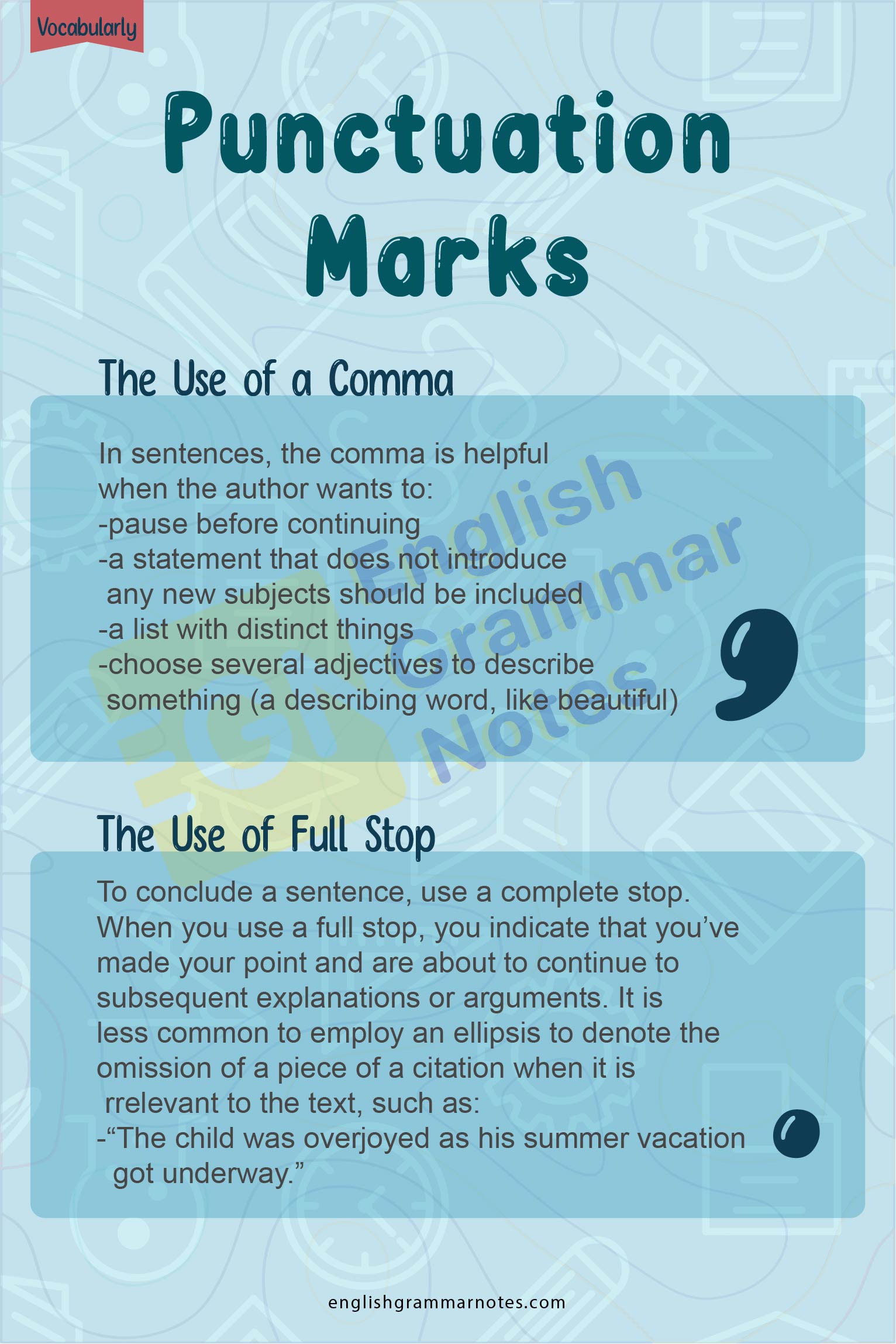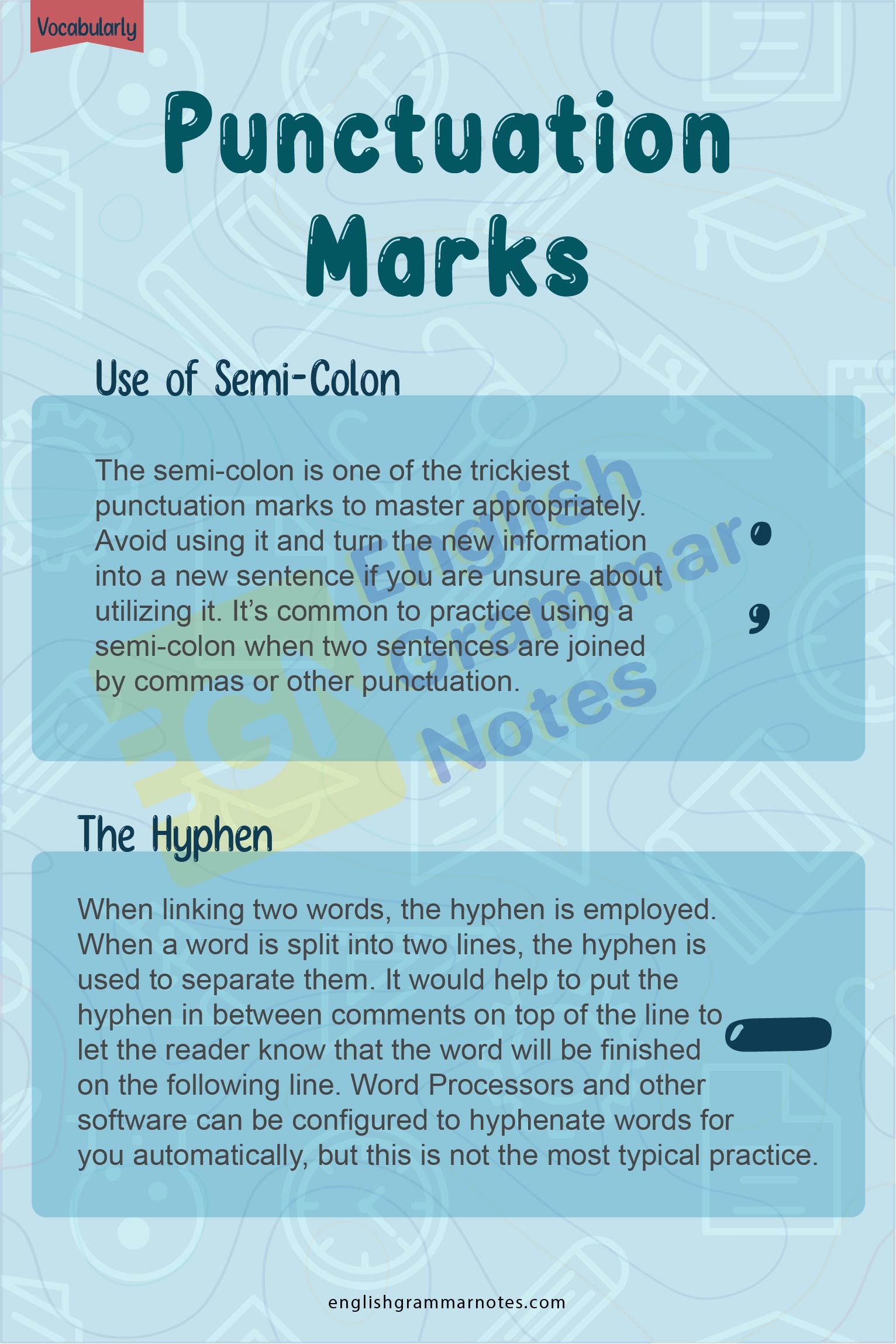Punctuation Marks: English Grammar lists 14 Punctuation Marks in general. In writing, punctuation signs include the periods (full stop), question mark (?), and exclamation point/mark (!). Other punctuation marks include the colon (dash) and hyphen (hyphenation). We’ll discuss the specific ones that we regularly use in our writing and that we need to become proficient with.
Before we can understand their use, we must first accept that it is punctuation that genuinely changes our words into standard and suitable structure-syntax or sentences in the first instance. If you don’t use Punctuation Marks, your work won’t convey your intended message.
Study the most important English Vocabulary Words identified by our experts and learn the right vocabulary to use in your day to day conversations.
Punctuation is a set of signals or symbols used to instruct the reader on the proper reading of a sentence. Sentences serve as the building blocks upon which written reports are constructed. There is no ambiguity in their words. Punctuation clarifies the meaning of a statement by showing the reader how to understand it.
Every sentence should begin with a capital letter and end with a complete stop, exclamation mark, or question mark, whatever is appropriate for the situation. Using this simple approach, you can tell when a sentence is finished.
- The Use of a Comma (,)
- The Use of Full Stop (.)
- Use of the Exclamation Mark (!)
- Use of Question Mark (?)
- Use of Semi-Colon (;)
- The Colon (:)
- Punctuation With An Apostrophe
- Use Quotation Marks Or Speech Marks (“….”) To Indicate A Quote
- The Hyphen is (-)
- A Set Of Brackets ()
- The Slash Character (/)
The Use of a Comma (,)
In sentences, the comma is helpful when the author wants to:
- pause before continuing
- a statement that does not introduce any new subjects should be included
- a list with distinct things
- choose several adjectives to describe something (a describing word, like beautiful)
Consider the following sentence: The phrase or clause in brackets gives us greater insight into what motivated the subject’s actions.
- The youngster dashed to the open door as his mother approached, knowing he was about to be left behind. Keep in mind that even if the phrase or clause were eliminated, the sentence still would make sense, even if some information were lost. Another option is to use two sentences.
- The youngster dashed through the open doorway. In the distance, he could make out the familiar face of his mother’s approaching car. To divide items in a list, you can use commas.
As an Illustration:
It was a full shopping cart with cans of coke, fresh fruit, veggies, toilet paper, bread, and milk cartons galore.
- The word ‘and’ connects the final two elements in a list rather than a comma.
- Commas separate adjectives.
As an illustration: Summer vacation had just begun for the young man, and he couldn’t wait.
It is good to read your work aloud and listen for natural pauses since commas signal a break in the action. A natural delay serves as a good indicator of where to put a comma most of the time. On the other hand, comma placement “rules” should be respected.
As an illustration:
Despite this, certain bees may prefer tree pollen.
The Use of Full Stop (.)
To conclude a sentence, use a complete stop. When you use a full stop, you indicate that you’ve made your point and are about to continue to subsequent explanations or arguments. It is less common to employ an ellipsis to denote the omission of a piece of a citation when it is irrelevant to the text, such as:
“The child was overjoyed as his summer vacation got underway.”
When indicating the abbreviation of regularly used nouns, a single full stop might be used as follows:
- Phone number is pronounced as “tel. no. “.
- September is abbreviated as Sept.
- The symbol pp represents pages.

Use of the Exclamation Mark (!)
An exclamation point denotes a strong emotion, such as fear, rage, or love, within a statement. Additionally, it’s employed to emphasize the feeling in both written and oral communication.
As an illustration:
“Help! “You have my heart!”
Thus, it can also serve as a clear instruction indicator.
“Stop! Police!” was the command.
or to express levity
He laughed and said, “Ha ha ha!”
Using an exclamation point instead of a full stop signals the finish of your statement.
If you want to emphasize something in your writing:
- Don’t use exclamation marks.
- If you think something is essential, don’t use a string in your text.
- Only use an exclamation point if it’s indispensable or directly derived from a source. You should avoid using exclamation points in official and semi-formal documents.
Use of Question Mark (?)
It simply signifies that a phrase asks a question by using a question mark. In every sentence, it’s at the end:
As an illustration:
Are we nearing the end of the road?
The question mark doubles as a period at the end of the sentence.
Use of Semi-Colon (;)
The semi-colon is one of the trickiest punctuation marks to master appropriately. Avoid using it and turn the new information into a new sentence if you are unsure about utilizing it. It’s common to practice using a semi-colon when two sentences are joined by commas or other punctuation.
As an illustration:
We got up early the following day and headed out; because the forecast seemed good.
Or
Passive behaviour refers to going along with what others want, while assertive behaviour refers to communicating one’s feelings, wants, and desires correctly.
To put together long lists, use the semi-colon.
As an illustration:
In Paris, France, Texas; London; Sweden; Colombo; Sri Lanka, and India, delegates from all of these places attended the meeting.
The Colon (:)
A colon in the middle of a sentence creates a sharp break between two sentences. The colon has two purposes:
Lists are the most typical place for it.
As an illustration:
Before heading out the door, she loaded the shopping cart with beer, fruit, veggies, toilet paper, cereal, and milk cartons.
A header or descriptive title can also be utilized.
As an illustration:
Phone Advisers’ Guide to Human Resources Management
Punctuation With An Apostrophe
There are two primary uses for the apostrophe, which is also known as an inverted comma. It’s important to note that the apostrophe denotes ownership or possession in this case.
As an illustration:
The girl’s headgear was a bright shade of green (girl is in the singular).
In this case, it’s clear to the reader who owns the hat: the girl.
The hats worn by the female students were a bright green (girls in this instance are plural, i.e., more than one girl, more than one hat).
This implies that the hats are the property of the women in the group.
The apostrophe can also be used to denote the omission of a letter:
As an illustration:
This course is going to be completed by the two of us. It’s going to be a course for us.)
Well, we did, punctuation masters! Doesn’t this show excellent command of punctuation?
It is presently seven o’clock in the morning. (It is now 7 o’clock in the clockwise direction.)
The fact is, many people misunderstand the words its and it’s. It lets the reader know when a letter is missing from a sentence.
As an illustration:
Using the phrase, it’s a nice day as a shorthand for the words it’s a lovely day.
It’s important to remember that shortening words aren’t appropriate in most formal writing.
For further information on correct apostrophe usage, see also: Common Writing Mistakes.
Use Quotation Marks Or Speech Marks (“….”) To Indicate A Quote
When using quotations or speech marks, be sure to keep the following in mind:
- to make a note of something
- When referencing the words of another person’s writing or speech,
As an illustration:
In the words of my grandfather: “Share your candy with your pals.”
Do not act in such a reckless manner, George!
“What about your books, by the way? “And now, shut down!” said Mrs Jones, the schoolteacher.”
To be clear, reporting back on an occurrence does not necessitate the use of speech or quote marks.
As an illustration:
Mrs Jones yelled at the students to put their books away and be quiet.
The Hyphen is (-)
When linking two words, the hyphen is employed.
As an illustration:
- sub-part
- week-end
- a lower-level position
- gender-neutral
- non-verbal
When a word is split into two lines, the hyphen is used to separate them. It would help to put the hyphen in between comments on top of the line to let the reader know that the word will be finished on the following line.
Word Processors and other software can be configured to hyphenate words for you automatically, but this is not the most typical practice.

A Set Of Brackets ()
If you want to make a side note or make a point that isn’t part of the main flow of a sentence, use brackets (). It’s possible the sentence still makes sense even if you eliminate the words in the stands.
As an illustration:
A strategy (or methods) chosen to fulfil goals may have to be adjusted as intervention progresses.
Square brackets [] can be used in a variety of ways.
- a way to condense long quotations
- to change a quotation’s tense to match your own sentence’s tense
- to fill in the blanks in a shortened citation with your own words
- the act of condensing long references in an article or report
The term “class” refers to a large-scale grouping of people who share shared economic resources and who can lead different types of lifestyles.
The Slash Character (/)
Instead of using or, and so on, many individuals use the slash instead. This is not always beneficial to the reader. In gender-neutral writing, the present convention is to use’s/he’.